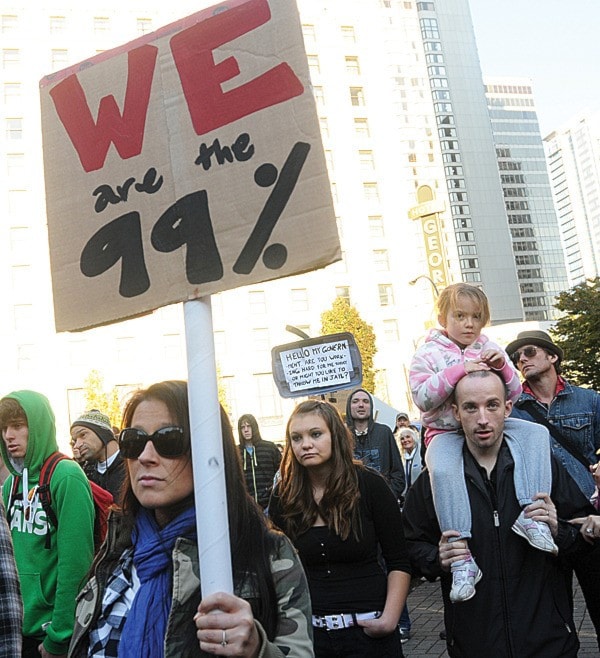Some approached the microphone with guitars, others gripped it tightly as their tirades bounced off the tall glass towers that surround the Vancouver Art Gallery.
Nathan Allen travelled from Delta to say his piece.
“I just want to say this inspires me greatly,” he bellowed, pausing for a moment to look over the crowd below him who had gathered for the first day of the Occupy Vancouver protest.
“It is incredible moment seeing all these people united in one purpose.”
A Dene woman, from Northern Alberta, spoke of how her land has been destroyed by tar sands projects and paved over for a trailer park. She ended her speech with a pointed, but profane rap.
In a line that snaked up and around the steps of the art gallery on Georgia Street, the young and old, able and disabled, employed and unemployed were all given a chance to speak.
Kristy Morley, 12, told the crowd that she wants change. The crowd replied with a loud “whooooo” and applause.
Standing in the throng behind a dad and his young daughter with sign that said “Think Democracy”, Jonathan Peters couldn’t help but feel inspired.
The Maple Ridge father, his wife Corisa Bell – who is seeking a council seat – and their daughters, Rhyly, 14 and Kaylyn, six, wanted to be there show their support.
“It is every faction of society that’s here, from 80-year-olds to three-year-olds,” said Peters, scanning the crowd around him.
“I think it’s important to be here, whether you agree with what is happening or disagree, it is happening and we need to understand why it is happening.”
Inspired by the Occupy Wall Street movement in New York City a month ago, the Occupy Vancouver protest began Saturday with a march through the city’s downtown core and grew to 4,000 people at its peak.
The protests are inspired by a grass roots movement against global financial inequality and corporate greed that has now spread to more than 80 countries.
The message: “We are the 99 per cent who will no longer tolerate the greed and corruption of the one per cent.”
While the timing and form of the movement was not predicted, Simon Fraser University history professor Mark Leier believes it was clear some kind of protest was developing, and necessary.
“We’ve seen wages and jobs and living standards leak away for 30 years. Entire generations have been told to suck it up, believe in the market, trust the old political parties, and have received little in return. The anger and frustration were entirely predictable,” Leier said.
“What matters now is whether these spontaneous movements can make strategic links with organized groups, especially the labour movement, and whether the pressure on business and politicians can be directed to clear ends and means.”
The protesters are doing just that – volunteers are committed to “an inclusive and welcoming space” and “an environment where all the 99 per cent can be heard and can meaningfully participate.”
The B.C. Federation of Labour is supporting the protests and Bank of Canada governor Mark Carney, a former Goldman Sachs investment banker, also endorsed them.
Share
If you attended or plan to attend the Occupy Vancouver protest, share your story with us by emailing editor@mapleridgenews.com.
